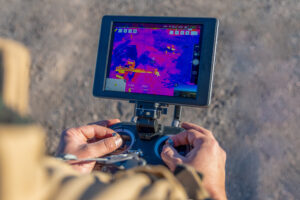
Man-flying drone with an infrared thermal camera
Before thinking about repairing or replacing a commercial roof, you need to do a proper inspection. That’s where an infrared roof moisture survey comes in.
With an Infrared Moisture Survey, you can accurately determine potential points of damage and assess an existing roof’s condition.
Understand what an Infrared Moisture Survey is, how the technology works, and why this tool can be a game changer for commercial roofers.
Are you a commercial roofing company looking to bring your inspection game to the next level?
Keep reading to find out just how an infrared survey can help your business.
What is an Infrared Roof Moisture Survey, Exactly?
An Infrared roof moisture survey is a non-destructive tool allowing roofers to accurately assess moisture damage in a low-slope roof.
It works on a very simple principle. During the daytime, water that has leaked into the roof’s substrate and saturated the roof’s insulation heats up.
Compared to dry areas that have not experienced leaks, a wet roof substrate will have higher mass, meaning it will also retain significantly more heat.
For this disparity in heat loss, an infrared roof survey uses an Infrared camera to identify damaged areas of your roof via its high amount of heat radiation.
To summarize, a section of a roof with leaks will radiate more heat than an undamaged section.
An Infrared Moisture Survey utilizes Infrared (IR) technology to visualize where this heat is radiating from.
These heat-producing points on a roof are typically signs of water/moisture damage.
How Does An Infrared Roof Moisture Survey work?
Typically, a roofing company would schedule an infrared survey before any work on a client’s roof starts.
For an Infrared moisture survey to be most effective, the roof should be already cleaned and dried.
Because an Infrared Moisture Survey works via heat detection, these surveys work best after a sunny day with little to no wind.
Infrared Roof Moisture Survey works by detecting the disparity in cool-down times, the survey should take place sometime after dark.
Basically, the roof needs time to let the dry sections cool down so that the wet, damaged areas are clearly visible in the IR camera.
After the survey is completed, a trained expert can read the images and diagnose exactly where the issues are so that the roofing team can develop a game plan.
What Are The Benefits Of An Infrared Roof Moisture Survey?
To start, one of the biggest benefits of an infrared moisture survey is that it can detect damages that are invisible to the naked eye.
Furthermore, because it uses IR technology, this type of inspection is totally non-destructive.
Preventing you from having to destroy potentially healthy sections of a roof to take a look at the subsurface.
It also is an incredibly time-efficient method of inspection in comparison to older, more invasive forms of roof inspection.
When you use IR technology to inspect a roof, you get a quick view of the entire roof’s condition and not just the sections a roofer has individually inspected by hand.
How An Infrared Roof Moisture Survey Saves You Money
There are a variety of ways infrared roof surveys save building owners money.
Infrared Moisture Surveys identify areas of a roof with damage caused by leaks.
Beyond harming your building, a wet roof is inefficient! Increased heat trapped combined with a damaged leaking roof costs more to cool.
In this way, an infrared survey points out to your roofers the exact places your roof is raising your energy costs!
Secondly, an Infrared moisture survey allows your roofer to work incredibly efficiently.
Instead of having to repair or replace an entire roof, an infrared survey allows each roofer to see the problem areas without tearing apart your roof.
Think about it like this: if your roof only has a few hidden but drastically damaged areas, why replace it all?
With an Infrared survey, your roofer can identify and fix only the damaged areas in your existing roof.
Common Causes Of Leaks That An Infrared Survey Can Identify
With a commercial roofing system, there are a set of common problems that cause your roof to leak.
To start, probably some common causes of a leak are damaged roofing membrane, penetration damage, or damaged seam.
With all of these, a common cause is weathering. Weathering could mean a temperature change, causing cracks due to a roofing material’s inability to elongate.
These could also be damaged by extreme weather, bringing hail or large debris damaging a roof.
Another major source of leaks is due to drainage issues. When a roof’s drainage system is damaged, ponding water is bound to occur.
With ponding water, roofs unequipped to handle it will deteriorate, causing leaks into your substrate.
Finally, damage, weathering, or general deterioration of the seals on a roof can cause leaking.
We are talking about the seals that protect other elements of your roof that protrude, such as skylights, HVAC units, or chimneys.
When these get damaged, water can leak into the roof’s subsurfaces.
How The Instacoat Premium Products IPP Roof Restoration System Can Help
Whether you are a building owner or a roofer, our silicone restoration system can help your roof!
Because of its superior elongation, our system can withstand large temperature fluctuations without cracking.
Instacoat’s system is fully resistant to leaking ponding water, meaning your roof will be protected even if ponding occurs.
Beyond fixing your roof’s leaking problems, once you install our system, your building will benefit from even more energy efficiency!
Our system reflects 88% of UV Rays, saving building owners additional money in their energy costs!
To put in perspective, this could mean up to a 33% reduction in your annual energy costs (according to the California Energy Commission.)
IPP wants to thank you for reading! To learn more about our Roof Restoration System, click here.
If you want to learn more about our unmatched warranty program, click here.
